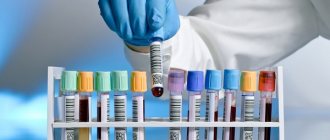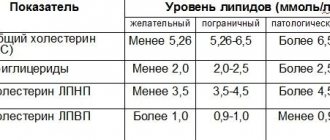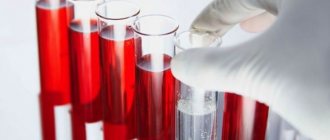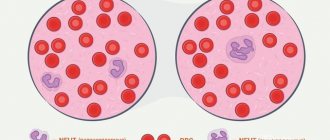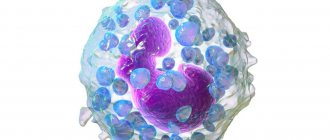In what cases is a study prescribed?
The analysis can be prescribed by pediatric doctors of various profiles: orthopedist, hematologist, gastroenterologist, oncologist, etc. The study is an important component of diagnosis if the child has:
- bones hurt;
- deformed bone structures;
- bones often break;
- weakness, apathy, fatigue;
- loss of appetite;
- nausea, vomiting, abdominal pain;
- jaundice;
- dark urine or light stool.
Alkaline phosphatase levels are determined during routine medical examinations of the child and in preparation for surgery. The analysis is also necessary to monitor the effectiveness of treatment of diseases of the bones, liver, kidneys, and biliary tract.
ALP - what is it, appointment for analysis
ALP is a group of enzymes that perform very important functions in the human body
Alkaline phosphatase is always present in the blood, since cells tend to renew themselves and die, releasing elements of their contents into the blood.
Alkaline phosphatase is found in almost all tissues of the human body; the largest number of enzymes is found in liver cells, bile ducts, and bone cells.
ALP in a biochemical blood test is an indicator of the health or pathology of not only the liver and bones, but also the kidneys and other organs. For example, this indicator increases during pregnancy, since a large amount of alkaline phosphatase is contained in the placenta. During bone growth, childhood and adolescence, ALP levels also increase due to bone activity.
The level of enzyme in the blood varies depending on age.
A blood test for ALP is prescribed in the following cases:
- General condition check. The ALP indicator is included in the biochemical blood test. Its compliance with the norm can be checked during a preventive examination, as well as if the patient voluntarily wishes to verify his health.
- During pregnancy. While pregnant, a woman often donates blood. A biochemical blood test contains 80% of information about the state of the body, so if necessary, a pregnant woman can donate blood every 2 weeks. ALP analysis in this case will be an indicator of the integrity of the liver and kidney tissues.
- For signs of liver damage. An ALP test may be prescribed for the following symptoms: nausea, weakness, vomiting, heaviness after eating, pain in the right hypochondrium. These signs may indicate liver disease, obstruction of the bile ducts.
- For bone diseases. ALP levels increase with bone fractures, but in this case x-rays are more informative. An alkaline phosphatase test is prescribed for bone diseases, as well as suspected metastases in bone tissue.
How to properly prepare for a test for the level of alkaline phosphatase in the blood of a child
Before donating blood for laboratory testing, you must adhere to a number of recommendations:
- You need to take the test on an empty stomach, you cannot eat 12 hours before the test (if the test is taken from an infant, the period of abstinence from food is reduced to 1.5-2 hours);
- do not drink 8-12 hours before the test;
- make sure that the child is not worried before the study and is in a stable emotional state;
- avoid physical activity on the eve of the test;
- do not give the child aspirin, paracetamol, antibiotics, allopurinol, which increase the activity of alkaline phosphatase (the possibility of discontinuing medications or postponing the test to another time, if medications cannot be canceled, must be agreed with the doctor);
- do not take the test immediately after physiotherapeutic procedures, x-rays and other instrumental studies;
- Bring your child to the clinic for a blood draw in the morning.
Biomaterial for research
A nurse collects biomaterial for laboratory testing. For the study, serum is used, which is obtained from venous or capillary blood. The blood is collected into a vacuum tube and then centrifuged to separate the serum. After this, the serum is collected in a clean tube and studied in the laboratory. Qualitatively selected biomaterial allows you to determine the level of alkaline phosphatase, compare the indicator with the norm, and determine the excess or deficiency of the enzyme in the body.
Reasons for lowering ALP
Low phosphatase results from conditions in which the release of these isoenzymes into the blood decreases. Most often, this phenomenon is associated with the presence of disturbances in the metabolic processes of calcium and phosphorus in the patient’s body.
Reasons for low phosphatase levels:
- Osteoporosis in older people, when senile destruction of bone tissue occurs.
- A significant decrease in the functioning of the thyroid gland, called myxedema.
- Situations when radioactive isotopes accumulate in bone tissue.
- Anemia of various etiologies, which has a pronounced character.
- The presence of scurvy, when there is a severe deficiency of vitamin C in the body. Such situations can arise when following strict diets or a long period of fasting, for example, during a radical fight against excess weight.
- A severe excess of vitamin D in the body. Similar situations are observed in cases where a person uncontrollably and in large doses takes medications containing this vitamin, in particular those prescribed by doctors to young children to prevent rickets.
A decrease in alp is observed with vitamin deficiency or hypovitaminosis, in particular with insufficient amounts of B vitamins in the diet and with a lack of the amount of magnesium, zinc and phosphorus necessary for normal functioning.
In addition, some medications, in particular sulfonamides and statins, can reduce rates.
A program for increasing this enzyme in the body should be prescribed by a doctor after conducting an examination and accurately determining the cause of this disorder. In some cases, the patient may be prescribed a special diet, adherence to which will help correct the situation, but most often patients require specialized individual treatment.
Norms for alkaline phosphatase levels in children
There are specific standards for alkaline phosphatase in children, with which the results of the analysis are compared. The indicator directly depends on the age and gender of the child, since at different age periods children actively grow bones, which results in an increase in the enzyme content in the blood.
Blood phosphatase levels are measured in units per liter (U/L). The following enzyme content standards have been officially adopted:
| Child's age | Floor | Normal level of alkaline phosphatase in the blood, units/l |
| until the 15th day of life | male/female | 83 – 248 |
| from 15th day to 1 year | male/female | 122 – 469 |
| 1 year – 10 years | male/female | 142-335 |
| 10 – 13 years | male/female | 129 — 417 |
| 13 – 15 years | male | 116 – 468 |
| female | 57 – 254 | |
| 15 – 17 years old | male | 82 – 331 |
| female | 50 – 117 | |
| 17 – 18 years old | male | 55 – 149 |
| female | 45 – 87 |
Profile No. 1, Blood biochemistry - standard
Home / For clients / Comprehensive studies / The set of tests included in the package collectively costs 5% - 15% less than each test separately. / Profile No. 1, Blood biochemistry - standard
Article rating: 4.24 (108)
Blood chemistry
- an important study that allows the analysis of various microelements in the blood to assess the functional state of organs and systems of the human body
Alanine aminotransferase (ALT, ALT, ALT)
is an enzyme contained in tissues in the liver and released into the blood when it is damaged. Elevated ALT levels can be caused by viral, toxic or other liver damage. With viral hepatitis, ALT levels can fluctuate over time from normal values to several normal values, so this enzyme must be monitored every 3-6 months. It is generally accepted that the ALT level reflects the degree of hepatitis activity, but about 20% of patients with chronic viral hepatitis (CVH) with a consistently normal ALT level have serious liver damage. It can be added that ALT is a sensitive and accurate test for the early diagnosis of acute hepatitis.
Aspartate aminotransferase (AST, AST, AST)
is an enzyme contained in the tissues of the heart, liver, skeletal muscle, nervous tissue and kidneys and other organs. An increase in AST together with ALT in patients with chronic hepatitis may indicate necrosis of liver cells. When diagnosing chronic hepatitis, special attention should be paid to the AST/ALT ratio, called the de Ritis ratio. An excess of AST over ALT in patients with chronic hepatitis may indicate severe liver fibrosis or toxic (drug or alcohol) liver damage. A significant increase in AST indicates necrosis of hepatocytes, accompanied by the breakdown of cellular organelles.
Bilirubin
is one of the main components of bile. Formed as a result of the breakdown of hemoglobin, myoglobin and cytochromes in the cells of the reticuloendothelial system, spleen and liver. Total bilirubin includes direct (conjugated, bound) and indirect (unconjugated, free) bilirubin. It is believed that the increase in bilirubin in the blood (hyperbilirubinemia) due to the direct fraction (more than 80% of total bilirubin is direct bilirubin) is of hepatic origin. This situation is typical for chronic hepatitis. This may also be due to impaired excretion of direct bilirubin due to cytolysis of hepatocytes. An increase in concentration due to free bilirubin in the blood may indicate extensive damage to the liver parenchyma. Another cause may be a congenital pathology - Gilbert's syndrome. Also, the concentration of bilirubin (bilirubinemia) in the blood may increase when the outflow of bile is obstructed (blockage of the bile ducts). During antiviral therapy for hepatitis, an increase in bilirubin can be caused by an increase in the intensity of hemolysis of red blood cells. With hyperbilirubinemia above 30 µmol/l, jaundice appears, which is manifested by yellowing of the skin and sclera of the eyes, as well as darkening of the urine (urine takes on the color of dark beer).
Gamma-glutamyl transpeptidase (GGT, GGTP)
- an enzyme whose activity increases in diseases of the hepatobiliary system (a marker of cholestasis). Used in the diagnosis of obstructive jaundice, cholangitis and cholecystitis. GGT is also used as an indicator of toxic liver damage caused by alcohol and hepatotoxic drugs. GGT is assessed together with ALT and alkaline phosphatase. This enzyme is found in the liver, pancreas, and kidneys. It is more sensitive to disorders in liver tissue than ALT, AST, alkaline phosphatase, etc. It is especially sensitive to long-term alcohol abuse. At least five processes in the liver increase its activity: cytolysis, cholestasis, alcohol intoxication, tumor growth, drug damage. In chronic hepatitis, a persistent increase in GGTP indicates either a severe process in the liver (cirrhosis) or a toxic effect.
Alkaline phosphatase (ALP, ALKP)
used to diagnose liver diseases accompanied by cholestasis. A combined increase in alkaline phosphatase and GGT may indicate pathology of the biliary tract, cholelithiasis, or impaired bile outflow. This enzyme is located in the epithelium of the bile ducts, so an increase in its activity indicates cholestasis of any origin (intra- and extrahepatic). An isolated increase in alkaline phosphatase levels is an unfavorable prognostic sign and may indicate the development of hepatocellular carcinoma.
Glucose
used in the diagnosis of diabetes mellitus, endocrine diseases, and pancreatic diseases.
Albumin
- the main blood plasma protein synthesized in the liver. A decrease in its level may indicate liver pathology caused by acute and chronic diseases. A decrease in the amount of albumin indicates severe liver damage with a decrease in its protein synthetic function, which occurs already at the stage of liver cirrhosis.
Total protein (Protein total)
- the total concentration of proteins (albumin and globulins) found in the blood serum. A strong decrease in total protein in the analysis may indicate insufficiency of liver function.
Creatinine
is the result of protein metabolism in the liver. Creatinine is excreted by the kidneys in the urine. An increase in creatinine levels in the blood may indicate a disruption in the normal functioning of the kidneys. The test is done before antiviral therapy to assess its safety.
A standard package of biochemical tests allows you to promptly identify abnormalities in the body’s condition, make the correct diagnosis and develop a treatment program. The recommended frequency of examination is once every six months.
- AST
- ALT
- G-GTP
- total bilirubin
- direct bilirubin
- total cholesterol
- total protein
- protein fractions
- alkaline phosphatase
- glucose
- urea
- creatinine
Profile cost
— 2261 rub.
Execution time : 1-2 days
Preparing for analysis
Note:
Blood sampling for testing is paid additionally. The cost of taking blood is 110 rubles.
© 2013 - 2021 copyright holder LLC "TIAS LOTUS"
History and philosophy of the company Personal data processing policy For citizens with disabilities Preparation for analyzes Phone numbers of higher-level organizations State guarantee program Payment methods Help for the Federal Tax Service Contacts Our partners
Gemohelp mobile application
8-800-100-08-05
Call if you have any questions
By using the website www.gemohelp.ru, you agree to the use of cookies
I confirm
More details
Select city:
- Arzamas
- Balakhna
- Bogorodsk
- Bor
- Vacha
- Vyksa
- Dzerzhinsk
- Trans-Volga region
- Kstovo
- Kulebaki
- Lukoyanov
- Lyskovo
- Moore
- Navashino
- Nizhny Novgorod
- Pavlovo
- Sarov
- Semenov
- Sosnovskoe
- Cheboksary
- Chkalovsk
Confirm
What do deviations of alkaline phosphatase from normal levels indicate?
Test results are not a diagnosis. To diagnose the pathology, the data obtained must be shown to the attending physician. The doctor will be able to establish a diagnosis based on a comprehensive assessment of the analysis for alkaline phosphatase, as well as other laboratory and instrumental tests.
Determining the level of alkaline phosphatase in children may show an excess of the actual value from the norm or its underestimated level. The most common causes of elevated alkaline phosphatase levels are:
- diseases of the bile ducts, liver: parasitic and infectious lesions, hepatitis, cirrhosis, oncology, tuberculosis, stones in the bile ducts and gall bladder;
- diseases of bone tissue: fractures, rickets, osteitis deformans, osteomalacia, osteosarcoma, bone metastases;
- pathologies of the blood and hematopoietic system: myeloma, lymphogranulomatosis, infectious mononucleosis, leukemia, circulatory failure;
- infarction of the kidneys, lungs, myocardium, kidneys;
- intestinal perforation, ulcerative colitis;
- cytomegalovirus infection;
- deficiency of calcium, phosphates in the diet;
- physiological characteristics of premature babies.
Causes of insufficient alkaline phosphatase levels:
- deficiency of zinc, magnesium, protein;
- low hemoglobin;
- hypovitaminosis of vitamins B12 and C;
- hypothyroidism;
- disorders in the growth and formation of bone tissue: achondroplasia, hypophosphatasia;
- hereditary hypophosphatasemia.
Detailed description of the study
Alkaline phosphatases (ALP) are a group of enzymes that catalyze the reaction of the removal of phosphates from various molecules, usually proteins. The name of enzymes is due to the fact that they exhibit maximum biochemical activity in an alkaline environment.
Alkaline phosphatase is a collective term: in the body the enzyme is presented in the form of several fractions. The largest amount of alkaline phosphatase is found in the liver, the walls of the bile ducts and bones, and to a lesser extent in the intestinal mucosa, kidneys and placenta - an organ formed during pregnancy to connect mother and fetus. Normally, 80% of the ALP level in the blood consists of the liver and bone fractions of the enzyme.
As an enzyme, alkaline phosphatases catalyze reactions in the formation of components of cell membranes (phospholipids), carbohydrates, ATP molecules (the main source of energy in the body) and other nucleotides, as well as bone tissue structures.
Under physiological conditions, serum alkaline phosphatase levels may vary with age. In young children and adolescents, enzyme concentrations may increase as a result of bone growth and development. Adult men may have lower ALP values than women.
Also, a physiological increase in the enzyme can be observed in pregnant women, especially during the third trimester. This is due to the active production of alkaline phosphatase by the placenta. In the presence of clinical symptoms - most often itching and less often yellowing of the skin - an increase in alkaline phosphatase may indicate cholestasis in pregnancy. In this case, you need to consult your doctor as soon as possible.
Excessive levels of alkaline phosphatase in the blood can occur in pathologies of the bone and urinary systems. However, most often the indicator increases in diseases of the liver and biliary tract.
Bile is a biological fluid that is formed in the liver. Its main functions include:
- Emulsification and absorption of fats in the wall of the small intestine;
- Removal of bilirubin and cholesterol from the body.
Liver cells secrete bile, which first enters the cavity of the duodenum (small) intestine through intrahepatic and then through extrahepatic ducts. Part of the bile is stored in a special organ located on the lower surface of the liver - the gallbladder.
When the outflow of bile is disrupted, stagnation occurs (cholestasis). The causes of this pathological condition can be different - stone getting into the ducts, compression of them by a tumor, etc. Clinically, cholestasis can occur in the form of skin itching, less often jaundice (yellowness of the sclera, skin and/or mucous membranes, darkening of urine and discoloration of feces) - for due to the large amount of bilirubin entering the blood from the liver.
It has been established that with cholestasis the level of alkaline phosphatase in the serum begins to increase sharply. This is a response of the liver in response to a violation of the outflow of bile. Moreover, if the obstacle is at the level of the extrahepatic ducts, the increase in alkaline phosphatase in the blood is more pronounced.
This study is advisable to carry out when diagnosing the following diseases:
- Obstructive jaundice due to cholelithiasis, neoplasms of the liver, bile ducts, pancreas;
- Liver inflammation, cirrhosis due to infectious, autoimmune and other pathologies;
- Malignant bone tumors and bone metastases.
Where to get tested
If your child needs to be tested for alkaline phosphatase levels in St. Petersburg, the children's medical office offers its services. We see young patients every day, helping to obtain the most accurate and reliable examination results in the shortest possible time.
Contact the pediatrician and you can:
- Get help from professional, experienced nurses who know how to approach children and turn blood donation into a quick and painless process.
- Get analysis results quickly. We have our own laboratory center at our disposal, which allows us to obtain results in the shortest possible time. The result can be collected at the registration desk or received by email.
- Do not doubt the results of the study. Our laboratory is equipped with European-style medical equipment, which reduces the likelihood of error to almost zero.
- Pass a set of additional tests as part of additional diagnostics. In our medical center you can undergo a wide range of laboratory tests and undergo all the necessary instrumental studies.
- Call a nurse to collect biomaterial at home. If you cannot visit the clinic or bring your child, we will provide a service to call a doctor at home.
- Get help from a specialized doctor and advice from related specialists. At SM-Clinic you can receive a full range of medical services, from highly accurate diagnostics to effective treatment.
To find out prices for tests or clarify any other questions, call us at the phone number listed on the website or fill out the electronic feedback form.
Indications for the study
Analysis is prescribed in the following cases:
- The appearance of health complaints soon after a sore throat or skin lesion, if there is reason to believe that the cause of their appearance is a previous streptococcal infection. Usually the test is prescribed 2-3 weeks after the illness. The value of the test increases significantly if it is performed several times at intervals of about 2 weeks. In this case, the dynamics of the results makes it possible to most reliably assess the patient’s condition.
- Treatment of complications of streptococcal infection. The analysis is prescribed by the doctor 7-14 days after the start of treatment in order to assess its effectiveness and, if necessary, adjust the previously prescribed therapy.
